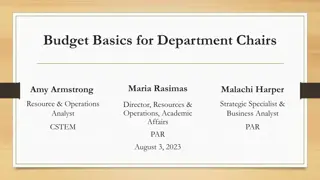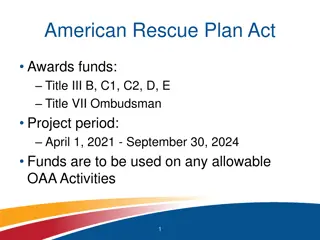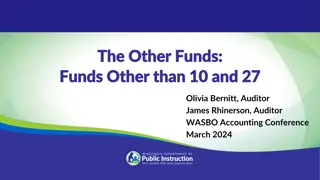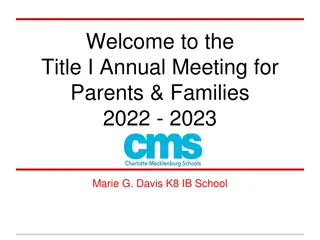Guide to Allocating Title I Funds to Schools - June 2018
Federal Title I, Part A funds are vital for districts with high numbers of children from low-income families. This guide outlines the process of selecting Title I schools and allocating funds based on poverty percentage and school performance. Key steps include obtaining the district's Title I allocation, determining reservations, and identifying schools that require additional services. The overall goal is to effectively distribute funds to support the implementation of Title I programs.
Download Presentation

Please find below an Image/Link to download the presentation.
The content on the website is provided AS IS for your information and personal use only. It may not be sold, licensed, or shared on other websites without obtaining consent from the author.If you encounter any issues during the download, it is possible that the publisher has removed the file from their server.
You are allowed to download the files provided on this website for personal or commercial use, subject to the condition that they are used lawfully. All files are the property of their respective owners.
The content on the website is provided AS IS for your information and personal use only. It may not be sold, licensed, or shared on other websites without obtaining consent from the author.
E N D
Presentation Transcript
Selecting Title I schools and allocating funds June 2018
Overview 1. Introduction 2. Obtain the district s Title I allocation and school Accountability & Assistance Levels 3. Determine district-level reservations 4. Determine if rank ordering by poverty percentage is needed for school-level funding a. For districts/charter schools with only one school per grade span b. For districts/charter schools with enrollment less than 1,000 students 5. Select the basis for determining poverty 6. Choose the method for qualifying schools 7. Rank all schools in descending order by the percentage of greatest poverty 8. Identify schools having the greatest need for additional services 2 9. Allocate funds to schools 10. Determine the actual per-pupil amount for each Title I school Massachusetts Department of Elementary and Secondary Education
Introduction Federal Title I, Part A funds are allocated to districts with high percentages or high numbers of children from low-income families. In turn, districts must identify Title I schools and assign funds to those schools based on poverty percentage. Districts may also consider school performance when funding school- and district-level supports and interventions with Title I. The primary purpose of this guide is to provide to Title I Directors and other district staff a brief overview of the process used in selecting and allocating funds to schools for the purposes of implementing Title I programs. 3 Massachusetts Department of Elementary and Secondary Education
Obtain the districts total Title I allocation and accountability and assistance level District Title I, Part A allocations: http://www.doe.mass.edu/grants/ District accountability and assistance levels: http://profiles.doe.mass.edu/statereport/accountability.aspx 4 Massachusetts Department of Elementary and Secondary Education
Determine district-level reservations Step 1 District Reservations Equitable participation for private school students Family engagement Neglected & Delinquent programs Administrative costs Professional development Preschool programs Homeless students Foster Care transportation Indirect costs 5 MTRS Massachusetts Department of Elementary and Secondary Education
Determine if rank ordering by poverty percentage is needed for school-level funding For districts/charter schools with only one school per grade span: 6 Massachusetts Department of Elementary and Secondary Education
Determine if rank ordering by poverty percentage is needed for school-level funding For districts/charter schools with enrollment less than 1,000 students: 7 Massachusetts Department of Elementary and Secondary Education
Select the basis for determining poverty Economically Disadvantaged Data x 1.6 multiplier Economically Disadvantaged Data Other Note: Poverty data may be used by itself or in combination with two or more other sources. ESE preloads Economically Disadvantaged data into the Title I, Part A grant application as the default source of poverty data. Districts may opt to use other sources if there is compelling reason to do so. 8 Massachusetts Department of Elementary and Secondary Education
Choose the method for qualifying Title I schools Total Grade span grouping & district-wide percentage Grade span grouping & group-wide percentage District-wide low-income percentage One school per grade span Grade span grouping & 35% rule enrollment less than 1,000 35% Rule Note: When possible, consider allocating funds in accordance with academic need. 9 Massachusetts Department of Elementary and Secondary Education
Rank all schools in descending order by the percentage of greatest poverty 10 Massachusetts Department of Elementary and Secondary Education
Identify schools having the greatest need for additional services For each school, consider: Accountability and assistance Level Low-performing subgroup(s) Presence of additional funding (beyond Title I) 11 Massachusetts Department of Elementary and Secondary Education
Allocate funds to schools Base school allocations on the per-pupil amounts and low- income enrollment for each school Include required accountability-related district-level reservations for targeted supports and interventions Note: Minimum per-pupil amounts are set for districts serving schools under 35% poverty. Districts serving only schools at or above 35% poverty can set the per-pupil amount. 12 Massachusetts Department of Elementary and Secondary Education
Determine the actual per-pupil amount for each Title I school Based on each school s total allocation divided by the number of low-income students enrolled in the school Per-pupil allocations must either be equal across all served schools in the district or descend in the order of poverty percentage for each served school School allocations must meet minimum funding requirements based on minimum per-pupil allocations and low-income enrollment 13 Massachusetts Department of Elementary and Secondary Education
Questions? Resource Allocation Strategy and Planning (781) 338-6230 federalgrantprograms@doe.mass.edu www.mass.mass.edu/federalgrants 14 Massachusetts Department of Elementary and Secondary Education























